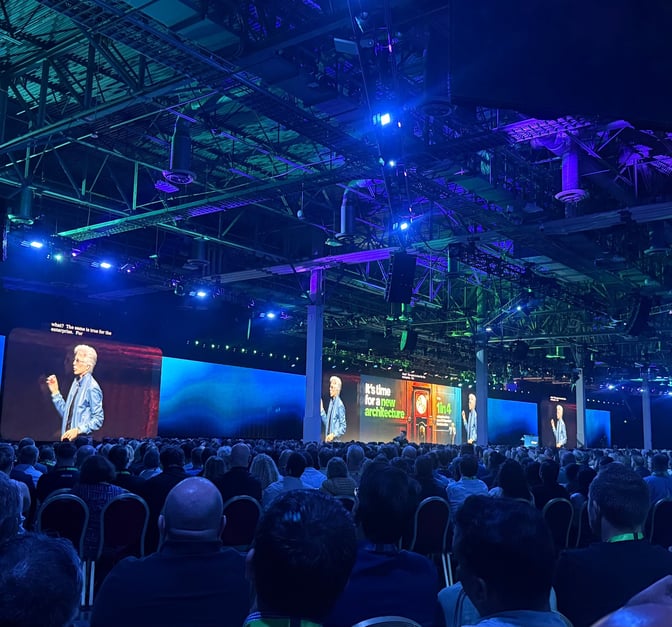July 15 2025
Knowledge 2025 and Real Cases
Wake Up, Everyone.
“It is everywhere, it is all around us.” – This iconic line from Morpheus about the Matrix could easily be describing AI today.
Today, I want to share with you the main highlights from the opening keynote of Knowledge 2025, ServiceNow’s global event held in Las Vegas. The theme was sharp and clear: “Put AI to work for people – now.”
Day 1: The Age of AI Has Already Begun
ServiceNow CEO, Bill McDermott, opened with a bold statement: “AI is the greatest opportunity of the century for civilization. It is the gateway to prosperity and an absolute requirement for survival.”
He emphasized that AI represents a $22 trillion opportunity by 2030.
But here’s the catch: despite massive investments, only 25% of companies are actually seeing results from digital transformation.
So, there’s still a long way to go — and AI will be the key differentiator.
A New AI Platform
ServiceNow launched a platform capable of integrating any AI model, agent, or workflow, in strategic partnerships with NVIDIA, Microsoft, Google, and Oracle.
The goal? Eliminate data silos and drive true automation.
What are data silos?
They’re isolated data repositories within organizations, typically separated across departments or systems — a major blocker to efficiency.
New Tools: AI Control Tower and Agent Studio
Amit Zavery introduced two powerful innovations:
AI Control Tower – a central command hub for managing and governing AI agents. You can now control any AI — inside or outside of ServiceNow — and plug it into your workflows and data.
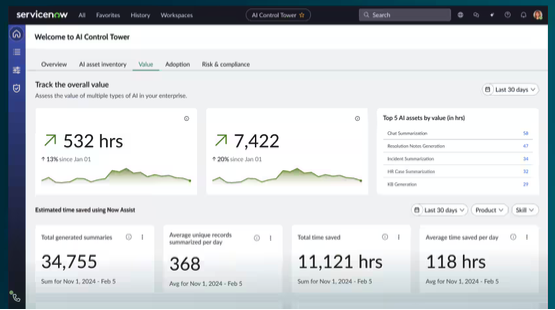

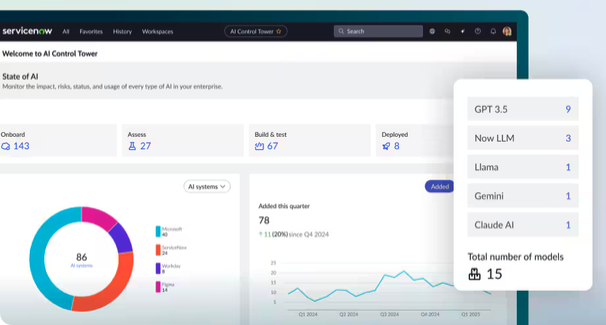



AstraZeneca
AstraZeneca saved over 90,000 hours through onboarding and R&D automation.
Here, R&D refers to everything related to discovering, developing, and testing new medications.
Automating these processes helps to:
Accelerate clinical studies
Speed up data collection and analysis
Reduce time-to-market for new treatments
Ensure regulatory compliance with less manual effort
In short, less bureaucracy, more scientific innovation.
Aptiv
Aptiv reduced costs and boosted productivity using ServiceNow.
They build automotive technology — helping the cars of the future run better.
But the magic doesn’t just happen inside the car. Inside the company, they were full of manual processes, repetitive tasks… that kind of bureaucracy nobody likes.
That’s where ServiceNow comes in.
They’ve already automated over 450 processes, including:
IT
Security
HR
Logistics and supply chain
All of it powered by artificial intelligence — solving issues before anyone even has to make a request. Wow, that’s a dream.
And there’s more: they’re also partnering with Wind River, a company that helps make network infrastructure faster and more secure.
In short, they’re connecting everything: cars, data, people, global teams… all flowing through one intelligent system.
The goal?
Less red tape. More action. Finally.
More time to innovate.
And more focus on what truly matters.
A Unified CRM
No more fragmented systems. ServiceNow introduced a unified approach to sales, customer service, and operations, all within a single platform.
So, what does a CRM actually do?
Stores customer data (names, purchase history, contact info, preferences…)
Tracks interactions (emails, calls, meetings, support requests)
Helps sales, marketing, and support teams work in sync
Delivers reports and insights to support better decision-making
Introducing ServiceNow University
ServiceNow University is the official learning platform from ServiceNow, designed to help people develop the skills needed in an AI-driven world. It offers a personalized learning experience by combining cutting-edge technology with engaging, modern teaching methods.
What’s inside?
Free, gamified courses: Hundreds of on-demand classes with practical assessments. Learners can earn credentials, points, and badges to track their growth.
AI-powered unified profile: A consolidated view of each user’s skills, experiences, and achievements — creating a personalized learning journey.
Who is it for?
ServiceNow University is open to everyone: employees, customers, partners, and anyone looking to level up their ServiceNow skills. Whether you’re just starting out or already a seasoned professional, there’s content tailored for you.
Link: https://learning.servicenow.com/now/lxp/home
Go check it out.
By 2027, the goal is to train 3 million professionals through personalized learning tracks. Pretty incredible, right?
Partnership with NVIDIA
And to close on a high note, Jensen Huang (CEO of NVIDIA) took the stage at Knowledge 2025 alongside Bill McDermott to talk about the game-changing partnership between ServiceNow and NVIDIA.
Let’s be clear — this partnership is next level.
They’ve teamed up to build AI agents that truly understand what we need — and get things done more intelligently.
They introduced the Apriel Nemotron 15B
It’s a massive AI model with 15 billion parameters.
It can interpret complex instructions, break them down, search for accurate answers, and deliver them with precision.
It’s basically a super smart assistant built into the ServiceNow platform.
If you’re into AI, automation, and innovation with real impact — now’s the time to dive in.
AI Agent Studio – a no-code tool that democratizes AI.
Anyone in your org can build, manage, and test AI agents and use cases.
The AI Agent Studio allows you to create, manage, and test AI agents and use cases all in one place. The main Overview page is divided into three sections, designed to give you everything you need to understand, get started, and continue building AI agents and use cases.
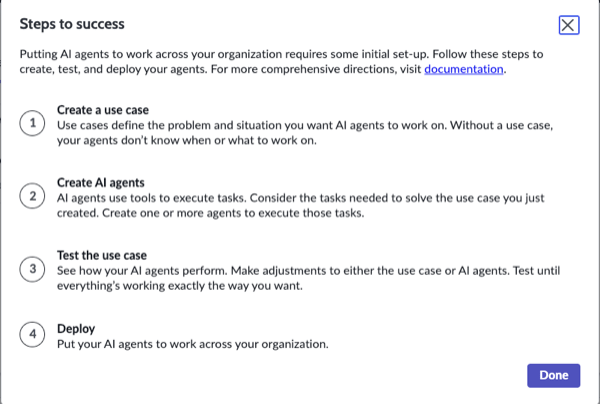



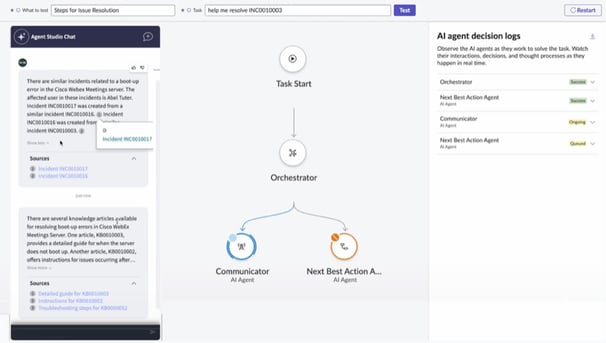

The final message? AI is not the future. It’s the now. And with ServiceNow + NVIDIA, AI is being put to work for people.
Day 2: Autonomous IT with AI Agents
ServiceNow expanded its vision of autonomous IT by embedding AI agents into areas like ITSM, ITOM, and ITAM. These agents automate incident communications, analyze monitoring tools to identify root causes, and perform self-healing actions — all aiming for a disruption-free environment.
RaptorDB Pro is ServiceNow’s new high-performance database, delivering queries 27x faster and transactions 53% more efficient. This ensures that large-scale workflows and AI inferences run in seconds, not minutes.
Core Business Suite
The Core Business Suite connects departments like HR, Finance, and Legal into a single portal, allowing employees to submit various requests — all managed by AI — with zero friction between departments.
The suite is preconfigured for quick deployment, with embedded agents that guide users and provide onboarding assistance.
CBS delivers a single portal where employees can submit expense reports, vendor inquiries, payroll questions, and workplace requests — all powered by AI-driven case management, intelligently routed across departments.
AI Agent Interoperability
In partnership with Google Cloud, ServiceNow is defining the open A2A (Agent-to-Agent) protocol. This allows intelligent agents from different providers to discover each other, exchange data, and execute tasks across systems.
It promotes seamless collaboration between AI agents, regardless of platform — AI talking to AI, working together to deliver more.
We’re no longer talking about a single AI working for us — we’re talking about true AI teams.
I have to confess: sometimes it was scary lol


Real Cases We Saw There
GRUPO GLOBO: Unification and Efficiency in Shared Services – Using FSM
This was a transformation case — a shared services unification project within one of the world’s largest media groups, proudly from Brazil. Check out the main takeaways and achievements:
1. A Real Transformation Opportunity
The group identified a major opportunity to optimize shared services (infrastructure, legal, and finance) across five regions in Brazil. Before 2004, systems were fragmented, manual, and lacked integration — making reporting and strategic decision-making difficult.
2. Successful MVP: Pilot with 50% Coverage
The project began with a pilot in a single building, achieving 50% operational coverage using only internal resources and no customizations. Over 900 items, 200 pieces of equipment, 200 maintenance plans, and 27 people were managed.
3. Strategic Expansion and Standardization
Standardizing processes enabled the expansion of the system to facilities in Jardim Botânico, Rio de Janeiro, and São Paulo — driving operational consistency and making centralized data control easier.
4. Impressive Results
17,000+ assets loaded (64x the initial volume)
3,000 maintenance instructions (11x more)
7,000+ tickets opened
1,000+ types of services
2,500 project hours
Deactivation of 2 legacy systems
All of this strengthened data centralization, improved SLA management, and optimized inventory and supply chain operations.
5. Next Steps and Future Vision
International expansion (New Zealand is on the radar!)
Integration with production sites
Asset governance (AAM)
Use of AI for management insights and asset tracking
Quotes That Stood Out
“We bring the power of content and technology together.”
“We have a duty and an important part to play in the future of our country and our planet.”
Key Lessons for the Team
Standardization and centralization are key to scaling operations
It’s possible to achieve significant results without customizations by focusing on internal DevOps
Client involvement and constant feedback were critical to system adoption
AI and asset governance will be a competitive advantage in future cycles
Final Recommendations
Keep promoting innovation based on data and technology
Scale the unified service model to new regions and units
Prioritize integration and governance as core pillars of efficiency
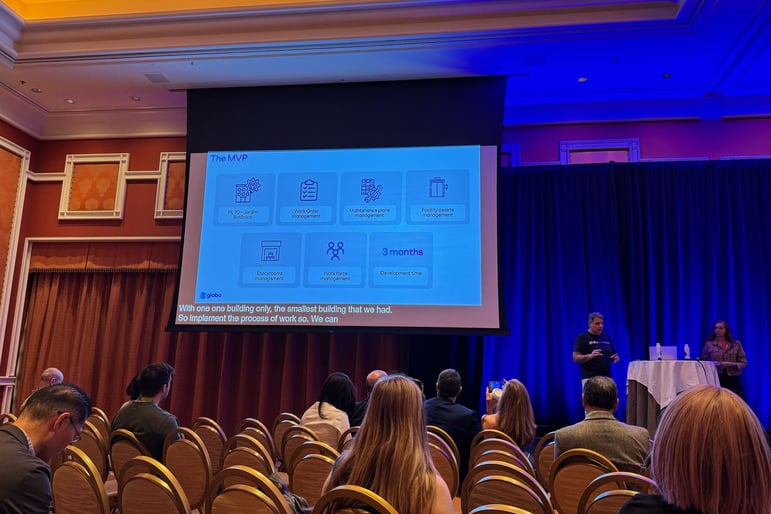

Digital Transformation at Bradesco: Innovation Through Intelligent Automation
This was Bradesco’s digital transformation case, showing how centralized automation is driving innovation, efficiency, and better customer experiences. Here are the key highlights that might inspire your own automation journey:
1. Automation as a Pillar of Transformation
Bradesco — the third largest bank in the world, with 82 years of history and over 8,000 employees (6,000 in tech) — sees automation as a catalyst for innovation, efficiency, and agility in its operations and digital services.
2. Challenges Overcome
Before centralization, the bank faced:
Lack of standardization and governance
Siloed automation initiatives
Poor control over KPIs and ROI
Difficulty in scaling and tracking automations
3. The Solution: ServiceNow Automation Center
The implementation took just 2 months and included:
Designing taxonomies and guardrails
Defining metadata
Hosting workshops with IT teams to ensure alignment
Close collaboration with ServiceNow and the Enterprise Impact Team
4. Strategic Features
Among the developed capabilities:
A user-friendly portal for launching automations (even for non-technical users)
Real-time monitoring
Integration with tools like Terraform, Ansible, and Automation Anywhere
Centralized registry and lifecycle tracking for each automation
5. Visible Results (2025)
30+ work hours saved
5% of alerts resolved automatically (self-healing)
66,000+ executions tracked
Centralized KPIs accessible to both IT and operations
6. Continuous Improvement as a Culture
The project reinforces the importance of:
Centralized governance and control
Integration with other platforms
Knowledge sharing across departments
Ongoing evolution and strategic customizations
Quote That Captures the Philosophy
“Automation is a catalyst for completion.”
Key Takeaways for the Team
Automation isn’t just technical — it’s a business strategy
Start with solid governance and cross-team engagement
Make automation accessible across the organization
Use data and KPIs as the foundation for decision-making and progress
Continuous improvement is just as important as the initial delivery
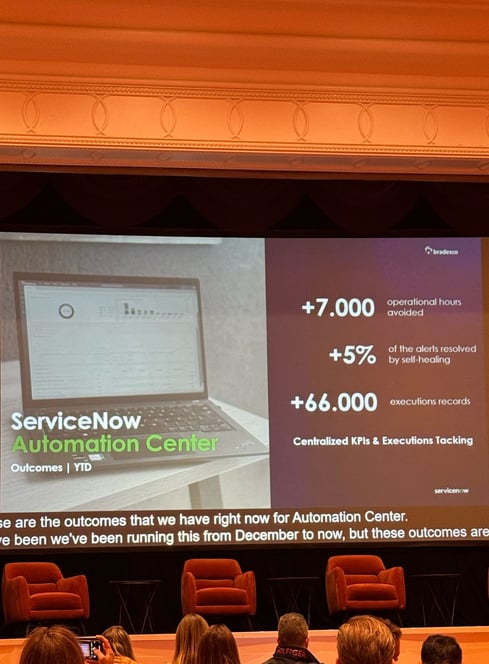

NOMURA Financial Services (Japan)
1. Current Challenges and the Need for Transformation
Excessive customizations were made due to regulatory and audit requirements, making it difficult to fully leverage ServiceNow’s out-of-the-box capabilities.
Many applications are not integrated and don’t operate on a unified platform.
Each company within the group has its own processes and non-standardized tools.
2. Objective
Decommission the current setup and replace it with a solution based on the CSDM (Common Service Data Model).
Modernize and standardize the user experience, business processes, and data model.
Leverage the full ServiceNow ecosystem, including new additions like ITAM and ILM.
3. Approach
Work clusters were created based on product areas, functioning as independent yet interconnected projects.
Priority was given to redesigning the CMDB data model and adopting CSDM.
Focus areas included cloud governance, security integration, asset management, and process automation.
4. Organization and Governance
400+ solutions are already running on the platform.
Teams are organized through a COE (Center of Excellence) with specialists in architecture, product engineering, operations, and user success.
Governance is shared between process owners (business side) and product owners (platform side).
5. About Nomura
Nomura operates in four core business areas: Wholesale, Wealth Management, Asset Management, and Banking, across more than 30 countries.
The company has approximately 27,000 employees, with a strong global presence (Tokyo, London, New York, India, etc.).
6. Nomura’s Global IT Strategy
Their strategy is built on two pillars: Resilience and Accelerated Innovation.
Key initiatives include system modernization, automation, enhanced employee experience, and data-driven decision-making.
ServiceNow was chosen as the platform to achieve these goals by unifying operations, eliminating silos, and strengthening governance.
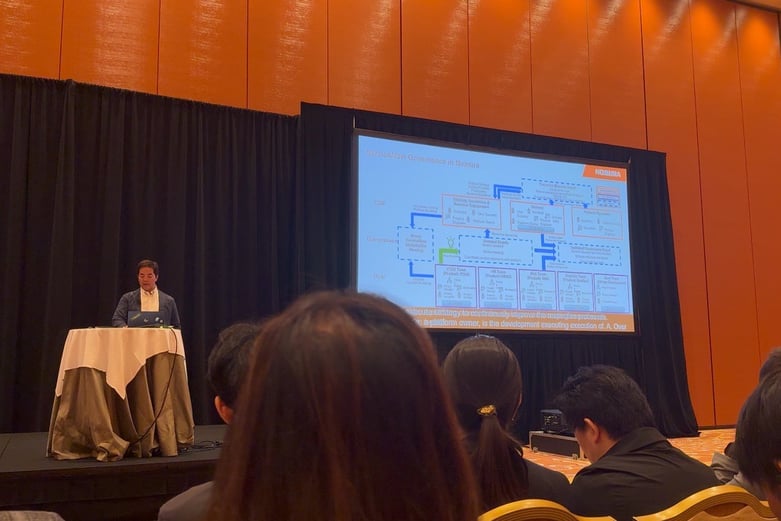

Campbell’s - How Campbell’s revitalized their ServiceNow Platform
1. Context and Initial Challenges
Campbell’s ServiceNow instance had low governance and little developer oversight, leading to:
2,800+ findings in HealthScan
34,000 violations in BPE (Best Practice Engine) — most were suggestions, not critical errors
Performance issues and upgrade disruptions, such as broken workflows after moving to Non-Prime
High developer turnover and difficulty maintaining technical quality
Dissatisfied users, especially with the portal (replaced 4 times in 5 years)
2. Choosing the Best Practice Engine (BPE)
Two tools were evaluated, and BPE was chosen because of:
A more user-friendly interface
Fully embedded in ServiceNow (no external systems)
A sales team that was approachable and non-pushy
The decision was made quickly by a small, autonomous team.
3. How BPE Works
BPE operates on two fronts:
Real-time – identifies issues during development
Nightly scans – sweeps the entire instance to uncover hidden problems
Includes over 600 best practice definitions, based on ServiceNow community and consulting experience
Supports the creation of custom rules
4. Features and Benefits
Interactive dashboards tailored for different profiles (developers, managers, etc.)
Proposed Fix – provides recommended solutions for detected issues, with one-click application
Self-healing agent prototype in development
Integration with Jira, Agile, etc., allowing creation of tickets directly within BAU operations
The main value: proactive prevention, boosting stability and reducing rework
5. Results at Campbell’s (in 1 year)
900 violations resolved
5,700 violations prevented
3,500 hours of technical debt eliminated
Improved governance and stronger communication with partners and ServiceNow
Weekly “show-me” sessions and monthly governance meetings were introduced
6. Lessons Learned
Drastically reduced unnecessary customizations
Investment in living documentation (still evolving)
New developers were onboarded into groups that follow BPE guidelines
The tool also became a continuous training instrument for developers
Final Reflections
Automating code reviews with BPE allows the team to focus on critical items like system property changes and table creation.
It fosters standardization, autonomy, and continuous learning, resulting in a more stable, scalable, and best-practice-compliant instance.
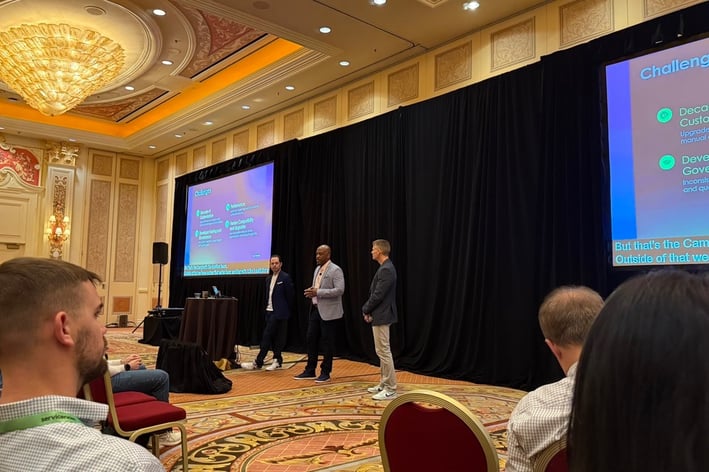

TELECOM
The speaker opened the keynote by sharing his personal journey before joining ServiceNow and his enthusiasm for the company’s culture. The presentation focused on the TMT sector (Telecom, Media, and Technology) and how innovation — while being the driving force of the industry — has also introduced challenges such as data silos, data overload, and difficulty turning insights into action.
1. AI Challenges in the TMT Sector
The industry still lags in AI maturity (10 points below the overall average)
Only 40% of companies have a clear vision of how AI will transform their business
Just half have appropriate compliance and governance policies in place
There’s a significant AI talent gap — only 40% feel adequately prepared
2. Proposed Solution: Platform Approach
ServiceNow promotes using a single platform to avoid disconnected tools across departments
Combining data + AI + workflows is essential to achieve ROI and true differentiation
The platform should be used cross-functionally (operations, business, and consumer areas)
3. Success Story: Bell Canada
The transformation from Telco to Techco was led by John Watson (President of Bell and Ateco):
The initiative began around 2 years ago, with a focus on customer, productivity, and AI
ServiceNow was chosen as the strategic platform for the transformation
They started with B2B and expanded into field service and consumer operations
Measurable results with AI include:
Proactive customer support
Reduced resolution time
Increased productivity
Accelerated time-to-market
4. How They Did It: The Transformation Structure
Created a business-led Center of Excellence (COE) with full authority over the platform
Required leaders to become more technical (including earning certifications)
Shifted organizational culture and career paths
Faced tensions with traditional IT, but achieved alignment by focusing on customer needs and delivery speed
5. AI in Practice
Bell has around 200 professionals dedicated to data and AI engineering
They use AI to support real-time decisions (e.g., reducing churn or optimizing technical visits in milliseconds)
The ServiceNow platform was key to operationalizing those decisions rapidly
Final Message
We’re living in a unique moment in tech history
Advice: Prepare your internal team to understand the customer, master AI, and know how to apply it — with the support of a strong platform
Conclusion: The Revolution Is Already Well Underway!!
Knowledge 2025 made it crystal clear: artificial intelligence is no longer a promise — it’s a reality being put into action right now.
From global enterprises to Brazilian institutions, we saw real-world examples of how ServiceNow is helping transform operations, unify experiences, break down silos, and free up time and energy to focus on what truly matters: innovating with purpose.
The combination of AI + data + workflows isn’t just a trend — it’s the foundation of a new way of working: more agile, intelligent, and connected.
If there’s one lesson that echoed across every keynote, demo, and conversation, it’s this:
Those who adopt now, lead the way.
So:


Nobody wants to be left behind, right?
Whether it’s with simple automations or large-scale transformation projects, the journey starts with one step: putting AI to work for people.
So, are you in?
In the meantime, follow me on Instagram @serviceneo_.
The future has already begun. And we’re wide awake for it.
#WakeUpServiceNeo
Authors
Neo [Daniel Dias]
&
Ellen Lopes - @ellen.lopes25
Content created live from Knowledge 2025, with lots of curiosity, caffeine, and a passion for transforming the way we work with ServiceNow.


And as a bonus: while strolling through Los Angeles, I found my outfit on display, without my consent!
Fashion crime or flattery?
Up to you! 😎🕶️


Knowledge 2025 and Real Cases
Main highlights of Knowledge 2025 Key Notes + Real Cases

